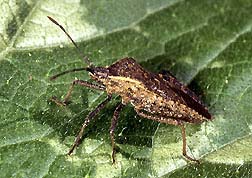Squash Bug

Squash the Squash Bug!
squash bug adult The squash bug can be misidentified as a stinkbug. Both insects look similar and emit a distinct odor when crushed; however, the stinkbug is not a pest of cucurbits and is more commonly associated with tomatoes or various legumes such as soybeans and peas.
Squash bugs feed on cucurbits (vine crops) and prefer squash and pumpkin. Both adults and nymphs cause damage by sucking nutrients from leaves and disrupting the flow of water and nutrients, which can cause wilting. Initially, before wilting, yellow specks will develop on the foliage that eventually turn brown. Under heavy feeding pressure, small plants can be killed; larger plants can have many affected leaves and vines. Subsequent wilting can look similar to bacterial wilt; however, bacterial wilt is a disease spread by striped cucumber beetles and is much more detrimental. Once the squash bug population is reduced, wilted plants should recover. By contrast, plants infected with bacterial wilt will continue to decline and will eventually die. Therefore, it is important to determine which wilt is occurring, and the correct identification of the insect pests present in the field is an essential first step. Squash bugs will also feed directly on the fruit, and it has become an increasing problem in recent years. Below is an example of squash bug feeding on fruit, near harvest.
If only a few plants are affected, it is most effective to hand pick and destroy squash bugs and eggs. Another option is to place boards or shingles on the ground next to the plants. At night the squash bugs will aggregate under the boards and can then be destroyed each morning. Using resistant varieties such as Butternut, Royal Acorn, or Sweet Cheese and maintaining a healthy plant through proper fertilization and watering are also important to limiting squash bug damage. It is also necessary to remove debris in and around the garden area that could possibly be used as shelter by the bugs. As stated above, by removing debris from the area, overwintering sites for the adults are reduced. Sevin is one of the few insecticides available to home gardeners.
Resource: Department of Entomology, University of Minnesota